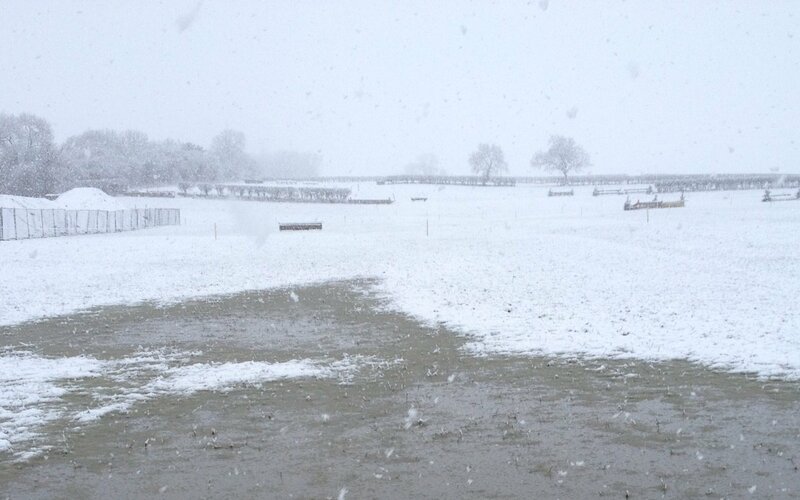
Your questions about Event Abandonment answered
Abandonment. It’s never a word any eventer likes to hear, particularly not when they are packing their lorry or car, bleary eyed at 5am, ahead of a long drive to a competition. But what does it mean in the world of British Eventing exactly, and what steps are actually taken during making the decision to abandon an event?
What does Abandonment mean?
“The act of giving up completely on a course of action” pretty well defines the term of abandonment – when the organisers of an event have persevered and tried all else to keep an event running, but it is deemed too unsafe to continue, only then will an event be abandoned. “Unsafe” is considered to be when the state of ground wouldn’t permit medical vehicles such as human and horse ambulances, to reach all areas of the event. Afterall, rider and horse safety is absolutely paramount and nothing can compromise that, no matter how much we want to continue.
What does it mean if an event is cancelled rather than abandoned?
On occasion an Event Organiser may take the difficult decision to cancel their event for varying reasons which may include insufficient entries or being unable to prepare the course due to unfavourable ground conditions. In this instance competitors will be refunded their entry fee, less the booking fee but including the abandonment insurance.
So how does the Abandonment process actually work?
When making an entry into a BE event, competitors pay an abandonment insurance fee which is automatically added to their entry. This means that in case of an event abandoning, entrants receive their entry fee minus this abandonment insurance and minus the booking fee back. Naturally some would rather avoid paying the fee and run the risk of cancellation, but with over 9000 fees refunded last year, the figures prove just how beneficial the system is to competitors who would have otherwise lost their entry fee altogether.
The abandonment fee also ensures that the organisers of cancelled events are reimbursed for the cost of setting it up. Without that fallback, many events just wouldn’t be able to continue year on year without this facility – it simply wouldn’t be financially viable for them.
The process of deciding whether or not to abandon an event is a robust one, that is to ensure more than one party is involved in the decision and in order to give events the best chance of continuing. The designated BE Steward along with the Technical Adviser (TA) assigned to each event work together in making the decision.
The abandonment fee also ensures that the organisers of cancelled events are reimbursed for the cost of setting it up. Without that fallback, many events just wouldn’t be able to continue year on year without this facility – it simply wouldn’t be financially viable for them.
The process of deciding whether or not to abandon an event is a robust one, that is to ensure more than one party is involved in the decision and in order to give events the best chance of continuing. The designated BE Steward along with the Technical Adviser (TA) assigned to each event work together in making the decision.
Inspecting the event site
Inspections of the venue are frequent, starting at least a week before the event and running all the way through to the early hours of the morning on each day of competition if the weather has deteriorated. But the situation is monitored well in advance behind the scenes if the BE Steward and TA are aware of a poor weather forecast leading up to the start date.
Those involved in the inspections will also include the organising teams behind each event, their course builders and even the landowner in order to assist with exploring all possible alternatives and actions before making the dreaded decision.
Notifying Members about an Abandonment
Sometimes, however, even the best laid plans and dry ground can be blighted by heavy overnight rain (or even snow at the beginning of the season), and all the efforts to keep the show on the road are curtailed. Once that heart-sinking call has been made to abandon, the BE Steward has to inform the Regional Coordinator who then gets in touch with the BE Office, where each weekend there is a designated member of staff on call. The person ‘on call’ will complete the following process within 10-15 minutes of getting the abandonment call:
- A text message is sent to all competitors
- The news is shared on British Eventing’s social media channels
- A notification is placed on the news section and event’s page of the BE website
The organising team at the event then have the tough job of contacting everyone associated with the running of the competition – contractors, medics, vets, sponsors and the amazing volunteers who give up their time to ensure these events can even run in the first place.
So why can’t events be abandoned based on a forecast?
Quite frankly, the answer is because a large proportion of the time the forecasts are inaccurate – weather patterns can change or move very quickly. This is why event officials and the BE Steward need to visit the event in person, in order to make a fully informed decision. It would be even more devastating than abandoning completely, if an event could have run but was abandoned too early.
It’s never an easy decision to abandon an event and it is extremely disappointing for all involved – competitors and organisers alike. But safety always has to be of the highest priority to ensure that British Eventing maintains its high standards and that riders and events are protected for the future.
How long does it take to process a refund?
We recognise that when an event is abandoned this can impact riders' cash flow when considering alternative events to enter. We have worked with insurers to shorten the process of refunds as much as possible. In order to process refunds;
- We first need a Steward’s Report and photographic evidence of the ground conditions leading to the decision to abandon.
- We then reconcile the entries taken and agree these figures with the Entry Secretary. Now that we are working with the BE EARS system the period of time to do this is shortened as we are all working on one common database but we still need to check in case the Entry Secretary has some pending actions, like refunding withdrawals for example.
- Once we have agreed the numbers we submit the claim to our brokers who then submit to insurers. Both work diligently to process the claim as quickly as possible and often within 72 hours.
Members should also be aware that once a refund has been made it can take up to 5 days for the it to appear on the card and it may appear on your statement the day the original entry was made rather than the date of the refund..
